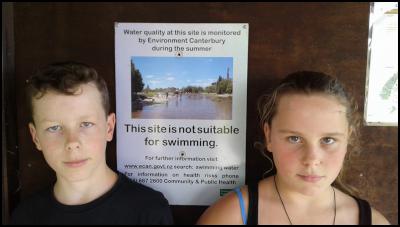Freshwater standards pose greatest risk for children
Media release
For release: Thursday 13 October 2016
Government’s freshwater standards pose greatest risk for children (Select Committee Hearing Tomorrow)

Jamie & Lia Roberts at Waihi
River near Geraldine where they used to be able to swim
Choose Clean Water will set a challenge for Select Committee when they make the case for clean rivers and lakes at parliament today.
The student-led group will ask MPs on the Local Government and Environment select committee to reject the Government’s controversial “wadeable” standard for freshwater and instead adopt the acceptable swimmable standard as New Zealand’s bottom line.
Both standards are based on the amount of E. coli bacteria present in the water, which is an indicator of faecal contamination.
Choose Clean Water campaigner Marnie Prickett says the proposed standard of “wadeable” poses the greatest risk for children.
“At the Government’s “wadeable” standard people walking or boating in water have a 5 per cent risk of campylobacter infection. That’s one person in 20.”
“What concerns us is that infection rates are based on threats to the health of adults and that guidelines state that risks are likely to be greater for children.”
The Ministry of Health found children are more vulnerable to diseases caused by E. coli and the harmful effects of toxic algae.
“It’s our young people who are most likely to spend their summer months wanting to swim in our waterways. But if you walked a class of school kids through a stream with the “wadeable” standard of contamination, more than one of them is at risk of going home infected,” said Prickett.
“When you compare the recreational freshwater guidelines and ecological health guidelines with the proposed National Policy Statement for Freshwater Management, it’s clear that the Government is increasing health risks to New Zealanders from waterborne disease and toxic algae to which children are particularly vulnerable. “
“The Government has a duty of care to young New Zealanders to keep freshwater clean and safe.”
“This is reckless legislation, weak in the face of ongoing pollution of freshwater. In its current form, New Zealanders cannot be confident that it is strong enough to protect the rivers and lakes they love.”
“It risks what is most precious to all New Zealanders, our health and that of our kids. And that’s why we will continue pushing for stronger protection for freshwater in law.”
ENDS
Additional Information
• The drinking water standard for freshwater is less than one E. coli per 100ml. The “wadeable” standard is 1000E. coli per 100ml.
• The National Policy Statement for Freshwater Management does not limit phosphorous in waterways, which contributes to algal growth
• 23% of New Zealand’s monitored groundwater is unsafe for human consumption.
• 74% of all native freshwater fish are considered threatened or at risk.


 Whanganui Regional Museum: Historic Wedding Dress Unveiled, A Piece Of Marton’s Heritage
Whanganui Regional Museum: Historic Wedding Dress Unveiled, A Piece Of Marton’s Heritage Donovan Ryan: Local Runner Takes Out Frontrunner Christchurch Marathon
Donovan Ryan: Local Runner Takes Out Frontrunner Christchurch Marathon University of Auckland: Tributes Flow For Much Loved Pacific Leader Melegalenu’u Ah Sam
University of Auckland: Tributes Flow For Much Loved Pacific Leader Melegalenu’u Ah Sam NZEI: Ministry Of Education Cuts Will Disproportionately Affect Pasifika
NZEI: Ministry Of Education Cuts Will Disproportionately Affect Pasifika Day One Hapai te Haeata: Call To Action For Young Filmmakers Against The Backdrop Of Funding Cuts
Day One Hapai te Haeata: Call To Action For Young Filmmakers Against The Backdrop Of Funding Cuts Toyota New Zealand: Three Races For Top Three To Decide TR86 Title
Toyota New Zealand: Three Races For Top Three To Decide TR86 Title